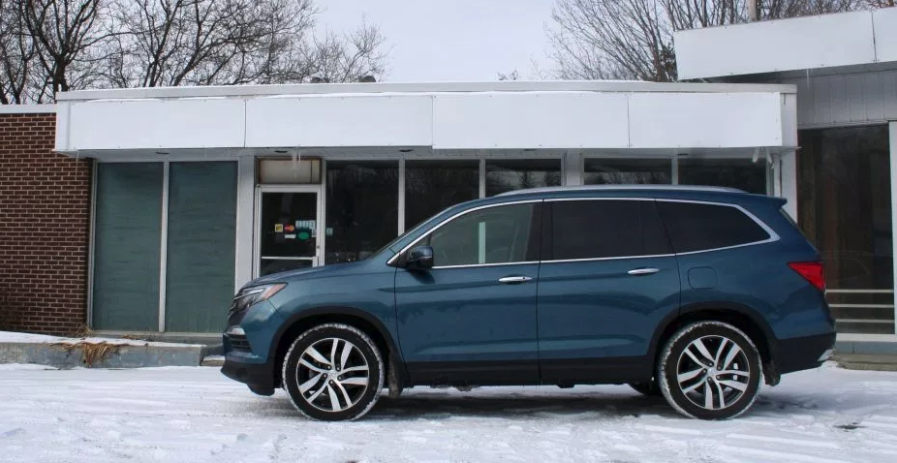Road Test: 2016 Honda Pilot Touring

Story and photo by John LeBlanc
If you’re interested in the new 2016 Honda Pilot, you’re probably also saving to put a few of your offspring through university. With seating for up to eight passengers, Honda’s midsize crossover has been popular with families looking for good value since it arrived in 2002. And although a minivan — like Honda’s excellent Odyssey — is cheaper to get into and easier to use (see sliding doors and lower step-in), there are plenty of image-conscious buyers who look at minivans as the equivalent of a wet blanket. For those buyers, know that the redesigned-for-2016 Pilot is more minivan-like than ever.
Like a minivan, passengers come first in the Pilot.
To begin with, this new, third-generation 2016 Pilot is the roomiest ever. Honda’s stretched the four-door crossover’s wheelbase and overall length. This not only benefits those in the second and third-row seats, but the Honda’s cabin feels much wider overall. The front seats no longer have a shared armrest, ditched in favour of individual flip down types. A low-slung, centre storage unit can now give front passengers more elbowroom.
As much as those sitting up front will be comfortable, the second-row may be the best seats in the Honda.
Our top line, all-wheel-drive $50,490 (prices do not include freight and pre-delivery inspection fees) Pilot Touring (base, front-wheel-drive models start at $35,490) removes the standard three-across second-row seats for a pair of so-called captain’s chairs (a term we’ve never understood — doesn’t the “captain” sit up front?) — a first for the Pilot and a feature parents love to separate scrapping siblings.
Like any good crossover, the Pilot still has conventional hinged side doors. Yet it’s now easier than ever to get in and out of the Honda’s third-row seats.
The top Pilot trim levels feature nifty one-touch buttons that swoosh the second-row seats forward, allowing for easier access to the back row. They may be easier to get to, but just like third-row setups in rivals such as the Toyota Highlander and Ford Explorer, the Pilot’s rear seats are best left to those who are aren’t college basketball prospects.
The Pilot also offers almost as much room as a minivan aft of its rear seats, whether that’s for groceries or goalie gear. With 510 litres of available room, there’s more than a Highlander but less than an Explorer.
It’s one thing for the midsize Honda crossover to be an accommodating rec-room-on-wheels, but the Japanese automaker also knows helicopter parents put safety near the top of their wish lists. No surprise, then, the 2016 Pilot is jammed with the latest in both dynamic and safety technologies. Check the Touring model’s specs, and you’ll find state-of-the-art safety stuff like Lane Keeping Assist, Lane Departure Warning, Road Departure Mitigation and Rear Cross Traffic Monitor systems.
Of course, another big reason new vehicle buyers have been opting for crossovers instead of minivans is the availability of traction at all fours (a feature only found on Toyota’s Sienna in the minivan segment). Replacing the last-generation Pilot’s VT-4 Lock feature, the 2016 model’s new Intelligent Traction Management System offers torque vectoring (that can dole out torque across the rear wheels to help to corner) for when the roads are dry, and three modes (sand, mud, and snow) when they are not (the latter of which came in handy during a record 51 centimetres of snow that fell in one day here in Ottawa).
There’s still a 3.5-litre six-cylinder engine as the Pilot’s lone choice of power. The new V6 is shared with its fancier Acura MDX platform-mate. Compared to the Pilot’s older six, the 2016 mill sports 280 horsepower and 262 pound-feet of torque, gains of 30 hp and nine lb.-ft., respectively.
Lower trims get a new six-speed automatic transmission, but our Touring version gets a new nine-speed with automatic stop-start technology. With the new Pilot being lighter than the 2015 model, fuel economy surprisingly doesn’t get much of a boost: estimates are 12.4 L/100 km city and 9.3 highway. We saw an indicated 12.8 during our wintry week in the Honda.
Roomier, safer, fuel-efficient — the redesigned 2016 Pilot seems less like an SUV and more like a minivan. The trouble is, the Honda crossover now drives more like a minivan, too.
Gone is the outgoing Pilot’s SUV-like ride. Yes, the new edition’s ride quality soaks up the worst of winter’s potholed roads. But there’s no flip-side to the Honda’s driving personality; no “sport” button to make it feel small into the corners or engaging to drive on a back road. The new electric steering is noticeable if only for its numbness. Great if you were getting your wisdom teeth pulled; not so great if you wanted to have some fun after dropping the kids off.
Is the 2016 Honda Pilot a minivan in SUV clothes? We think so.
Keen drivers can take a pass. But Honda’s midsize crossover (particularly in Touring form) is a very luxurious, practical and safe form of family transportation. It offers minivan-like room, tons of safety gear and is quiet and comfortable — no matter what shenanigans are going on in the second-row seats.




